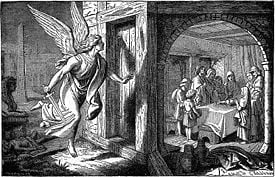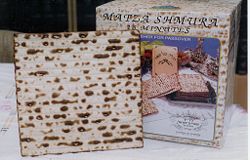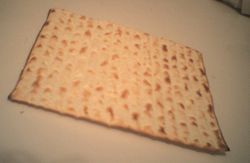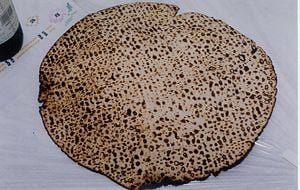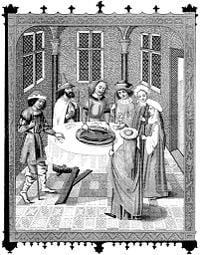Passover
Passover (Pesach, Pesakh)—also called the Festival of Unleavened Bread—is a Jewish holiday commemorating the Exodus and the freedom of the Israelites from ancient Egypt. It begins on the fifteenth day of Nisan (on the Hebrew calendar), normally in the early spring.
The name Passover (Pesakh, meaning "skipping" or passing over) derives from the night of the Tenth Plague, when the Angel of Death saw the blood of the Passover lamb on the door-posts of the houses of Israel and "skipped over" them (Exodus 12), refraining from killing their firstborn. The next day, the Pharaoh finally allowed the Israelites to leave Egypt. The ritual meal of the Passover Seder commemorates this event.
The name Feast of Unleavened Bread (Khag Ha'Matsot) refers to the week-long period when unleavened bread or matzo ("flatbread") is eaten instead of normal bread. This tradition recalls the hurriedly-baked bread that the Israelites ate after their hasty departure from Egypt. Together with Sukkot ("Tabernacles") and Shavuot ("Pentecost"), Passover is one of the three pilgrim festivals during which the entire Jewish populace was encouraged to make a pilgrimage to Jerusalem, at the time when the Temple in Jerusalem was still standing.
Passover also represents a point of conjunction between Judaism and Christianity, in that Jesus is depicted as traveling with his family to make the traditional Passover pilgrimage in Luke 2:41, and the Last Supper, in the synoptic Gospels, was a Passover Seder.
Origins of the festival
The verb "pasàch" (Hebrew: פָּסַח) is first mentioned in the Torah account of the Exodus from Egypt (Exodus 12:23). It is found in Moses' words that God "will pass over" the houses of the Israelites during the last of the Ten Plagues of Egypt, the killing of the first-born. On the night of that plague the Israelites smeared their lintels and door-posts with the blood of the Passover sacrifice and were spared.
The term pesach also refers to the lamb or kid which was designated as the Passover sacrifice (called the Korban Pesach in Hebrew). Four days before the Exodus, the Israelites were commanded to set aside a lamb or kid (Exodus 12:3) and inspect it daily for blemishes. During the day on the fifteenth of Nisan, they were to slaughter the animal and use its blood to mark their lintels and doorposts. Up until midnight on the fifteenth of Nisan, they were to consume the lamb. Each family (or group of families) gathered together to eat a meal that included the meat of the Korban Pesach while the Tenth Plague ravaged Egypt.
According to traditional accounts, in subsequent years, during the existence of the Tabernacle and later the Temple in Jerusalem, the Korban Pesach was eaten during the Passover Seder on the fifteenth of Nisan. However, following the destruction of the Temple, no sacrifices could be offered or eaten. The story of the Korban Pesach is therefore retold at the Passover Seder, and the symbolic food which represents it on the Seder Plate is usually a roasted lamb shank-bone, chicken wing, or chicken neck.
The English term "Passover" came into usage through William Tyndale's translation of the Bible in the sixteenth century, and later appeared in the King James Version as well.
Critical view
Modern biblical scholars often question the origin of Passover, believing that the ritual was probably not celebrated universally in ancient Judah and Israel, but instead was adopted relatively late. The Bible mentions two occasions when the holiday was instituted or re-instituted on the national level in the Kingdom of Judah: during the reign of King Hezekiah (2 Chronicles 30) and also during the reign of King Josiah (2 Kings 23). There is no record of its celebration officially in the northern Kingdom of Israel, although the Samaritans of a later era apparently celebrated it, as do the surviving Samaritans today.
A prominent theory is that the Passover tradition originated with one group among the people who later became known as the 12 tribes of Israel, and that this tradition was adopted officially as a national holiday in the time of Hezekiah and/or Josiah. It served to bolster the national mythology of the tribes as a national federation with a common origin (in Jacob) and a common legal tradition given by Moses. A similar scenario is seen as occurring in modern times when the United States adopted the tradition of Thanksgiving as a unifying national holiday in which most Americans participate today, even though few contemporary Americans have ancestors who were present at the first Thanksgiving.
The Passover Seder

It is traditional for a Jewish family to gather on the first night of Passover (first two nights outside the land of Israel) for a special dinner called a Seder (סדר—derived from the Hebrew word for "order," referring to the very specific order of the ritual). The table is set with the finest china and silverware to reflect the importance of this meal. During this ceremony, the story of the Exodus from Egypt is retold using a special text called the Haggadah. Four cups of wine are consumed at various stages in the narrative. The Haggadah divides the night's procedure into these 15 parts:
- Kadeish קדש (Recital of Kiddush blessing and drinking of the First Cup of Wine)
- Urchatz ורחץ (The washing of the hands)
- Karpas כרפס (Dipping of the Karpas in salt water)
- Yachatz יחץ (Breaking the middle matzo; the larger piece becomes the afikoman which is eaten later during the ritual of Tzafun)
- Maggid מגיד (Retelling the Passover story, including the recital of the "Four Questions" and drinking of the Second Cup of Wine)
- Rachtzah רחצה (Second washing of the hands)
- Motzi מוציא (Traditional blessing before eating bread products)
- Matzo מצה (Blessing before eating matzo)
- Maror מרור (Eating of the maror)
- Koreich כורך (Eating of a sandwich made of matzo and maror)
- Shulchan Oreich שולחן עורך (lit. "set table"—the serving of the holiday meal)
- Tzafun צפון (Eating of the afikoman)
- Bareich ברך (Blessing after the meal and drinking of the Third Cup of Wine)
- Hallel הלל (Recital of the Hallel, traditionally recited on festivals; drinking of the Fourth Cup of Wine)
- Nirtzah נירצה (Conclusion)
The Seder is replete with questions, answers, and special practices to arouse the interest and curiosity of the children at the table. The children are also rewarded with nuts and candies when they ask questions and participate in the discussion of the Exodus and its aftermath. Likewise, they are encouraged to search for the afikoman, the piece of matzo which is the last thing eaten at the Seder. The child or children who discover the hiding place of the afikoman are rewarded with a prize or money. In larger gatherings, audience participation and interaction is the rule, and many families' Seders last long into the night with animated discussions and much singing. The Seder concludes with additional songs of praise, faith, and even childish joy printed in the Haggadah.
In Reform Judaism and among non-observant families, Seders present opportunities for sharing the tradition of Passover with non-Jews. Orthodox families, however, generally observe the tradition that only those obligated to bring the Passover sacrifice to the Temple may participate in the feast.
Commandments
Note: The commandments regarding Passover are not observed strictly by most Jews. However, for Orthodox Jews, they represent an important and sacred obligation.
Korban Pesach
When the Temple was standing, the focus of the Passover festival was the Korban Pesach (lit. "Pesach sacrifice," also known as the "Paschal Lamb"). Every family or extended family was required to offer a young lamb or kid at the Jewish Temple on the afternoon of the fourteenth day of Nisan (Numbers 9:11) and eat it that night. Among those who could not offer or eat the Korban Pesach were: An apostate (Exodus 12:43), a servant (Exodus 12:45), an uncircumcised man (Exodus 12:48), a person in a state of ritual impurity. Women were obligated, as men, to perform the Korban Pesach and to participate in a Seder.
Today, in the absence of the Temple, the mitzvah of the Korban Pesach is memorialized in the form of a symbolic food placed on the Passover Seder Plate, which is usually a roasted shankbone. Ashkenazic Jews have a custom of not eating lamb or goat during the Seder in deference to the absence of the Temple. Many Sephardic Jews, however, have the opposite custom of eating lamb or goat meat during the Seder in memory of the Korban Pesach.
Matzo
The eating of matzo figures prominently in the Passover Seder. There are several explanations for the eating of matzo on Passover. Many hold that it is because the Hebrews left Egypt with such haste that there was no time to allow the bread to rise and thus flat bread, matzo, is a reminder of the Exodus. Other scholars teach that in the time of the Exodus, matzo was commonly baked for the purpose of traveling because it preserved well and was light to carry. They suggest that matzo was baked intentionally for the long journey ahead.
Chametz
Chametz (חמץ, "leavening") refers to either a grain product that is already fermented (e.g., bread, cake, and pasta) or a substance that can ferment grain products (e.g., yeast or sourdough).
The Torah commandments regarding chametz are:
- To remove all chametz from one's home (Exodus 12:15).
- To refrain from eating chametz or mixtures containing chametz during Passover (Exodus 13:3, Exodus 12:20, Deuteronomy 16:3).
- Not to possess chametz in one's domain during Passover (Exodus 12:19, Deuteronomy 16:4).
Traditionally, during Passover, the only grain product that can be owned or eaten is one in which flour and water have not combined for more than 18-22 minutes.
Maror

The Israelites were commanded to eat Maror, bitter herbs (typically, horseradish or romaine lettuce), together with matzo and the Passover sacrifice Exodus 12:8. In the absence of the Temple, Jews cannot bring the Passover sacrifice. This commandment is fulfilled today by the eating of Maror both by itself and together with matzo in a Koreich-sandwich during the Passover Seder.
Recounting the Exodus
On the first night of Passover (first two nights outside Israel), a Jew must recount the story of the Exodus from Egypt. This commandment is performed during the Passover Seder.
The four cups of wine
Though not commanded in the Torah itself, there is a rabbinic tradition, considered binding on observant Jews, to drink four cups of wine (or pure grape juice) during the Seder. This applies to both men and women. The Mishnah says (Pes. 10:1) that even the poorest man in Israel has an obligation to drink. Each cup is connected to a different part of the Seder: The First Cup is for Kiddush, the Second Cup is connected with the recounting of the Exodus, the drinking of the Third Cup concludes the meal and the Fourth Cup is associated with Hallel, the hymn of thanksgiving.
Observances
Removal and sale of chametz
In accordance with the mitzvah of not eating or owning leavened products during Passover, strictly religious Jewish families typically spend the weeks before the holiday in a flurry of housecleaning. The purpose is to remove every morsel of fermented grain products (called chametz) from all the cupboards and corners in the home. The search for chametz is often a thorough one, as children's rooms and kitchens are cleaned from top to bottom and forgotten packages or pieces of cookies or crackers are uncovered under beds and inside closets. Although many ensure that not even a crumb of chametz remains, the Halakha only requires the elimination of olive-sized quantities of leavening from one's possession.
Meanwhile, the family attempts to consume or dispose of all edible chametz products (like bread, pasta, cookies, soup mixes, and even non-kosher-for-Passover matzo) so as to have nothing left by the morning before the holiday begins.
Formal search for chametz
After dark on the 14th of Nisan, a formal search for leavened products (bedikat chametz) is conducted. The head of the house reads a blessing (על ביעור חמץ - al biyur chametz, "on the removal of chametz") and proceeds to go from room to room and cupboard to cupboard to make sure that no crumbs remain in any corner. There is a custom to turn off the lights in the room being searched and conduct the search using candlelight, a feather and a wooden spoon. Candlelight effectively illuminates corners without casting shadows; the feather can dust crumbs out of their hiding places; and the wooden spoon which collects the crumbs can be burned the next day with the chametz.
Traditionally, ten morsels of bread are carefully wrapped in aluminum foil or plastic and "hidden" around the house before the search begins. This ensures that the head of the house will find some chametz so that his blessing will not be in vain.
In the morning, any leavened products that were found during the search, along with the ten morsels of bread, are burned (s'rayfat chametz). The head of the household declares any chametz that may not have been found to be null and void "as the dust of the earth" (biyur chametz). Should more chametz actually be found in the house during the Passover holiday, it must be burnt.
Unlike chametz, which can be eaten any day of the year except during Passover, kosher for Passover foodstuffs can be eaten on Passover and year-round. They need not be burnt after the holiday ends.
Matzo baking
The weeks before Passover are also the time for the baking of the matzos which will be eaten during the holiday. In Orthodox Jewish communities, men traditionally gather in groups (chaburas) to bake a special version of handmade matzo called shmura matzo ("guarded matzo," referring to the fact that the wheat is guarded from contamination by chametz from the time it is cut in the summer until it is baked into matzos for the following Passover). Since the dough is rolled by hand, shmura matzos come out large and round. Chaburas also work together in machine-made matzo factories, which produce the typically square-shaped matzo sold in stores.
The baking process is a time-consuming job, as each batch of dough can only be worked on from start to finish (from mixing the flour and water to removing from the oven) for 18-22 minutes, depending on custom. Consequently, only a small amount of matzos can be baked at one time. The chabura members are enjoined to constantly work the dough so that it is not allowed to ferment and rise.
A special cutting tool is run over the dough just before baking to create the familiar dotted holes in the matzo. After the 18-22 minutes are up and the matzos come out of the oven, the entire work area is scrubbed down and swept to make sure that no pieces of dough are left behind. By definition, any stray pieces of dough are now chametz, and can invalidate the next batch of matzo if they come in contact with it.
Matzo by-products, such as matzo farfel (broken bits of matzo) and matzo meal (finely-ground matzo) are used as flour substitutes in the baking of Passover cakes and cookies.
Passover dishware
Due to the strict separation between matzo products and chametz during Passover, families typically own complete sets of serving dishes, glassware and silverware that are reserved for use during Passover only. Under certain circumstances, some chametz utensils can be immersed in boiling water (hagalat keilim) to purge them of any traces of chametz they have accumulated throughout the year. Many Sephardic families thoroughly wash their year-round glassware and then use it for Passover, as the Sephardic position is that glass does not absorb enough traces of food to present a problem.
Fasting of the firstborn
On the morning before Passover, the fast of the firstborn takes place. This fast commemorates the salvation of the Israelite firstborns during the Plague of the Firstborn (according to the Book of Exodus, the tenth of ten plagues wrought upon ancient Egypt prior to the Exodus of the Children of Israel), when, according to Exodus (12:29): "… God struck every firstborn in the Land of Mitzrayim (ancient Egypt)…."
In practice, however, most firstborns only fast until the end of the morning prayer service in synagogue. This is due to the widespread custom for a member of the congregation to conduct a siyum (ceremony marking the completion of a section of Torah learning) right after services and invite everyone to partake in a celebratory meal. According to widespread custom, partaking of this meal removes one's obligation to fast.
Other observances
In the Land of Israel the holiday lasts seven days and the first and last days are major holidays in which, in Orthodox and Conservative Judaism, no work is performed and most of the observances of Shabbat are adhered to. The Seder is conducted on the first day.
Outside the Land of Israel, in Orthodox and Conservative Judaism, the holiday lasts eight days, and the first two days and last two days are major holidays. A Seder is conducted twice, on both the first and second days. In the intermediate days work can be performed.
The intermediary days of Passover are known as Chol HaMoed (festival weekdays) and are imbued with a semi-festive status. It is a time for family outings and picnic lunches of matzo, hardboiled eggs, fruits and vegetables and Passover treats such as macaroons and homemade candies.
The prohibition against eating leavened food products and regular flour during Passover results in the increased consumption of potatoes, eggs and oil in addition to fresh milk and cheeses, fresh meat and chicken, and fresh fruit and vegetables. To make a "Passover cake," recipes call for potato starch or "Passover cake flour" (made from finely granulated matzo) instead of regular flour, and a large amount of eggs (eight and over) to achieve fluffiness. Cookie recipes use matzo farfel (broken bits of matzo) or ground nuts as the base. For families with Eastern European backgrounds, borsht, a soup made with beets, is a Passover tradition.
Some hotels, resorts, and even cruise ships across America, Europe and Israel also undergo a thorough housecleaning and import of Passover foodstuffs to make their premises "kosher for Pesach," with the goal of attracting families for a week-long vacation. Besides their regular accommodations and on-site recreational facilities, these hotels assemble a package of lectures given by a "rabbi in residence," children's activities, and tours to entertain Passover guests. Each meal is a demonstration of the chefs' talents in turning the basic foodstuffs of Passover into a culinary feast.
Counting of the Omer
Beginning on the second night of Passover, the sixteenth day of Nisan, observant Jews begin the practice of the Counting of the Omer, a nightly reminder of the approach of the holiday of Shavuot 50 days hence. When the Holy Temple stood in Jerusalem, the Omer was an actual offering of a measure of barley, which was offered each day between the sixteenth of Nisan and the eve of Shavuot. Since the destruction of the Temple, this offering is brought in word rather than deed.
Seventh day of Passover
Shvi'i shel Pesach (שביעי של פסח "seventh [day] of Passover") is another full Jewish holiday, with special prayer services and festive meals. Outside the Land of Israel in the Jewish diaspora, Shvi'i shel Pesach is celebrated on both the seventh and eighth days of Passover. This holiday commemorates the day the Children of Israel reached the Red Sea and witnessed both the miraculous "Splitting of the Sea," the drowning of all the Egyptian chariots, horses and soldiers that pursued them, and the Passage of the Red Sea.
Hasidic Rebbes traditionally hold a tish on the night of Shvi'i shel Pesach and place a cup or bowl of water on the table before them. They use this opportunity to speak about the Splitting of the Sea to their disciples, and sing songs of praise to God.
Second Passover
The "second passover" (Pesach Sheni) on the fourteenth of Iyar in the Hebrew Calendar is mentioned in the Hebrew Bible (Numbers 9:6-13) as a make-up day for people who were unable to offer the pesach sacrifice at the appropriate time due to ritual impurity or distance from Jerusalem. Just as on the first Pesach night, breaking bones from the second Paschal offering (Numbers 9:12) or leaving meat over until morning (Numbers 9:12) were prohibited.
Today, Pesach Sheni has the status of a very minor holiday, so much so that many Jews have never heard of it, and in practice it does not exist outside of Orthodox and traditional Conservative Judaism).
Passover and Christianity
The New Testament indicates that Jesus and his family celebrated Passover each year by taking part in the annual pilgrimage to Jerusalem. It was during one of these that Jesus reportedly stayed behind in the Temple and conversed impressively with the teachers in the Temple courts, after which he was scolded by his parents and taken back to Nazareth (Luke 2:41-50). Jesus also traveled to Jerusalem during the Passover pilgrimage as an adult. In the synoptic Gospels, though not in the Gospel of John, the Last Supper is a Passover Seder. In John's version, this meal takes place just before Passover, so that Jesus himself is presented as the paschal "lamb" who is sacrificed on the Cross. Jesus is similarly characterized as the sacrificial Passover lamb in 1 Corinthians 5:7 and Hebrews 11:28.
In early Christian tradition, the church celebrated the Resurrection on Passover; and in Jewish-Christian churches—especially in Jerusalem—the Passover feast itself apparently continued to be observed until at least the time of the destruction of the Temple in 70 C.E. Later, traditions differed in the various churches of the East and the West, some laying stress upon Friday as the historical day of the Crucifixion, others adhering to the Jewish custom of celebrating the fourteenth day of Nisan. Eventually, as Christianity began to define itself as a non-Jewish religion, the connection of the Jewish and the Christian Passovers was severed, and to celebrate Easter on the fourteenth day of Nisan was condemned as heresy. At the Nicene Council in 325 it was decided that the Christian Passover should be celebrated on the Sunday following the full moon of the vernal equinox (March 21). According to Eusebius, Eusebius (Life of Constantine, Book III chapter 18[13]), the Emperor Constantine I declared: "Let us then have nothing in common with the detestable Jewish crowd; for we have received from our Savior a different way." However, the custom of Christians and Jews joining in the Passover feast seems to have persisted, as St. John Chrysostom found it necessary to condemn such interfatih activities in his sermons. "The very idea of going from a church to a synagogue is blasphemous," he declared, and "to attend the Jewish Passover is to insult Christ."[1]
Chrysostom's attitude toward interfaith fellowship between Christians and Jews became the norm in late antiquity and the Middle Ages. It is only in modern times that Christians have begun again to seek fellowship with Jews during Passover. Conversely, not all Jews are willing to welcome Gentiles of any kind to join in the feast. However, in secular, Reform, and some Orthodox or Conservative Jewish traditions, Passover is seen as an opportunity to share the joy of Passover with Christians and other non-Jews.
Notes
- ↑ Saint John Chrysostom Eight Homilies Aginst the Jews Medieval Sourcebook. www.fordham.edu. Retrieved April 11, 2020.
ReferencesISBN links support NWE through referral fees
- Bradshaw, Paul F., and Lawrence A. Hoffman. Passover and Easter: Origin and History to Modern Times- Two liturgical traditions, v. 5. Notre Dame, IN: University of Notre Dame Press, 1999. ISBN 9780268038595
- Broadhurst, Donna, and Mal Broadhurst. Passover Before Messiah and After. Carol Stream, ILl: Shofar Publications, 1987. ISBN 9780936685007
- Prosic, Tamara, "The Development and Symbolism of Passover Until 70 C.E." Journal for the study of the Old Testament 414. London: T & T Clark International, 2004. ISBN 9780826470874
- Raphael, Chaim, and David Harris. A Feast of History; Passover Through the Ages As a Key to Jewish Experience. New York: Simon and Schuster, 1972. ISBN 9780671211752
External links
All links retrieved November 18, 2022.
- Passover www.angelfire.com
- Passover www.chabad.org
- Frequently asked questions about Passover www.askmoses.com
- Passover 18Doors
| Jewish and Israeli holidays | |
|---|---|
| Jewish holidays | Shabbat · Rosh Chodesh · Rosh Hashanah · Fast of Gedalia · Yom Kippur · Sukkot and Hoshanah Rabbah · Shemini Atzeret and Simchat Torah · Hanukkah · Tenth of Tevet · Tu Bishvat · Fast of Esther and Purim · Fast of the Firstborn and Pesach · Counting of the Omer · Pesach Sheni · Lag Ba'omer · Shavuot · 17th of Tammuz · The Three Weeks · The Nine Days · Tisha B'Av · Tu B'Av |
| Holidays in Israel | Yom HaShoah · Yom Hazikaron · Yom Ha'atzmaut · Jerusalem Day |
| Hebrew calendar months | Tishrei · Cheshvan · Kislev · Tevet · Shevat · Adar · Nisan · Iyar · Sivan · Tammuz · Av · Elul |
Credits
New World Encyclopedia writers and editors rewrote and completed the Wikipedia article in accordance with New World Encyclopedia standards. This article abides by terms of the Creative Commons CC-by-sa 3.0 License (CC-by-sa), which may be used and disseminated with proper attribution. Credit is due under the terms of this license that can reference both the New World Encyclopedia contributors and the selfless volunteer contributors of the Wikimedia Foundation. To cite this article click here for a list of acceptable citing formats.The history of earlier contributions by wikipedians is accessible to researchers here:
The history of this article since it was imported to New World Encyclopedia:
Note: Some restrictions may apply to use of individual images which are separately licensed.

